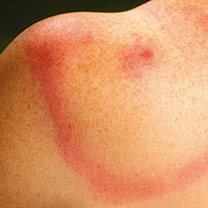Every year, people in the Netherlands have about 1.5 million tick bites. About 27,000 people get Lyme disease, and 1000 to 1500 of those have long-term symptoms.
What is Lyme disease?
Lyme disease is caused by the Borrelia burgdorferi bacterium. You can get Lyme disease from the bite of an infected tick. The tick becomes infected from sucking the blood of small animals (rodents) or birds that may carry the bacterium. When the tick later sucks blood from a human host, it can transmit the bacterium to that human. About 1 in 5 ticks carry the bacterium.
Video: What is Lyme disease?
De ziekte van Lyme wordt veroorzaakt door een bacterie.
Deze kun je oplopen door een tekenbeet.
Ongeveer 1 op de 5 teken draagt de lymebacterie bij zich.
De bacterie wordt niet bij elke tekenbeet overgedragen.
Heb je de ziekte van Lyme, dan kun je last krijgen van een vlek of kring rondom de plek van de tekenbeet.
Andere mogelijke verschijnselen zijn koorts en eventueel spier- en gewrichtspijn.
Op lange termijn krijg je soms andere huidklachten, zenuwklachten, gewrichtsklachten of hartklachten.
De ziekte van Lyme wordt behandeld met antibiotica.
Door zo snel mogelijk te behandelen verklein je de kans op langdurige klachten.
Heb je gezondheidsklachten en ben je de afgelopen 3 maanden gebeten door een teek?
Bespreek dit dan met je arts.
Meer weten?
Ga naar www.rivm.nl/lyme
Lyme disease is caused by bacteria.
You can get it from a tick bite.
About 1 in 5 ticks carry the bacteria that cause Lyme disease.
It is not transmitted with every tick bite.
If you have Lyme disease, you may get a rash or ring around the bite location.
Other symptoms include fever and possibly muscle aches and joint pain.
Over time, you may sometimes develop skin conditions, nervous complaints, joint problems or cardiac symptoms.
Lyme disease is treated with antibiotics.
Treatment as soon as possible reduces the risk of long-term symptoms.
Do you have health problems? And did you have a tick bite within the past 3 months?
Consult your doctor about it.
Would you like to know more? Go to www.rivm.nl/lyme.
Symptoms of Lyme disease
The symptoms of Lyme disease can vary greatly. Not everyone develops the same symptoms. Lyme disease can cause the following symptoms:
- Expanding discolouration of the skin at the location of the tick bite. This ‘ring’ around that spot can appear for up to three months after a tick bite. The discolouration may occur in various ways. Here are two examples. You can view more examples at www.tekenradar.nl.
- Fever, possibly accompanied by muscle ache and joint pain, in the first weeks after the bite.
- Joint problems, skin conditions, nervous complaints or cardiac symptoms may sometimes develop. This can occur if early symptoms of Lyme disease were not treated with antibiotics. However, these symptoms may also be the first signs of the disease.
Both the early and the later stages can be treated with antibiotics. However, if it progresses to a later stage, the infection may have already caused damage. For that reason, it is important to contact your GP if you have these symptoms.
People may sometimes be infected without having observed the skin rash. Tick bites are also often overlooked. That is why it is very important to check carefully for ticks after visiting green areas.
Different forms of skin rash from the bacteria that causes Lyme disease. The skin rash may look like a ring or an evenly coloured spot.
Treatment for Lyme disease
In order to diagnose Lyme disease, doctors will first assess the patient’s health problems, as well as their medical history and their behaviour (for example, if the patient is at high risk of getting tick bites because they spend a lot of time in nature). The doctor will also review the blood test values. This combined method is the best way to confirm Lyme disease. The method is described in the Institute for Healthcare Improvement (CBO) guideline on Lyme disease.
Lyme disease can be treated with antibiotics. The sooner the disease is identified, the more effective treatment will be. It is therefore important to inform your GP that you were bitten by a tick if you experience any health problems within 3 months after the bite.
Lyme disease treatment may vary per patient. To determine the most appropriate treatment, a national guideline was established in 2013: the Institute for Healthcare Improvement (CBO) guideline on Lyme disease. More information for GPs (in Dutch).
Treatment will initially be handled by your GP. If the symptoms persist after treatment with antibiotics, or if new symptoms develop despite treatment with antibiotics, the GP may refer the patient to a specialised hospital.
How often does Lyme disease occur?
Every year, over 1 million people get bitten by a tick. About 2 in 100 people get Lyme disease after a tick bite: some 27,000 people every year. The nature and severity of symptoms in patients with Lyme disease can vary greatly. The vast majority of people who get Lyme disease develop a characteristic ring or spot at the bite location. 1,200 to 1,500 people a year also develop additional joint problems, skin conditions, nervous complaints, or cardiac symptoms due to Lyme disease. Out of the 27,000 patients, an estimated 1,000 to 2,500 people continue to have persistent symptoms. The Lyme Prospect study is trying to find out why.

